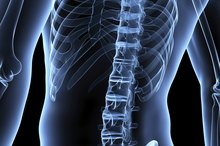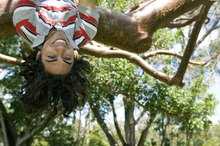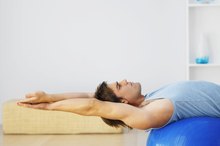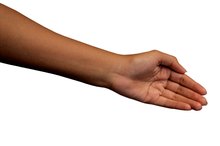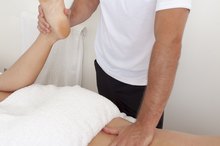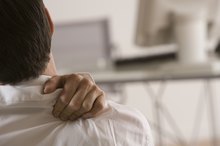Can an Inversion Table Help With Bulging Disks?
The spine is the part of your body most affected by the force of gravity. Due to gravity pulling down on the spine, the disks that rest between your spinal vertebra are at risk for compression. When gravity pulls the vertebrae down, the vertebrae can force some of the liquid in the disks to spill out, which becomes a bulging disk. Bulging disks are a common condition related to aging, but can happen to people of all ages. Oftentimes, bulging discs do not cause pain. But if the space between the disks becomes too narrow, pressure on the nerves will become painful. Inversion tables can counteract spinal compression.
History
Inversion therapy traces its origins as far back as 400 B.C. when Hippocrates used a ladder and pulley system designed to suspend a patient upside down and take pressure off the spine. In the 1960s, Dr. Robert Martin brought inversion therapy into the mainstream. Dr. Martin was a medical doctor, chiropractor and osteopath based in California. By the 1980s, inversion therapy became popular. Today, inversion therapy in the form of inversion tables and other inversion systems exist in the offices of medical professionals, gyms and even homes.
- Inversion therapy traces its origins as far back as 400 B.C.
- when Hippocrates used a ladder and pulley system designed to suspend a patient upside down and take pressure off the spine.
- In the 1960s, Dr. Robert Martin brought inversion therapy into the mainstream.
Benefits
Do Inversion Tables Work for Back Pain?
Learn More
Rocking on an inversion table is an effective method for treating bulging disks. This movement reduces pressure on the vertebrae and disks through spinal decompression. The inversion table places your body at angles with the head downwards so that gravity elongates the spine instead of compressing it, creating spinal decompression. By pulling the vertebrae away from each other, the disks have adequate room for their contents. A bulging disk is like a jelly doughnut mushed between your palms. The vertebrae trap it and push to force the liquid out when the space between the vertebrae is too narrow.
Spinal decompression can also reduce sciatica pain because it lessens the pressure on the sciatic nerve, which is the largest nerve in the body. The sciatic nerve runs along each side of the lumbar spine and down the back of the leg.
- Rocking on an inversion table is an effective method for treating bulging disks.
- The inversion table places your body at angles with the head downwards so that gravity elongates the spine instead of compressing it, creating spinal decompression.
Method
Intermittent or oscillating traction on an inversion table can help bulging and herniated disks by stretching the spine and increasing blood circulation. Blood circulation brings waste away from bulging disks. To perform oscillating traction, lie on an inversion table with your body upright. Alternatively, rock backwards to invert upside down and stay there for 20 to 30 seconds and then move forward until you are upright. Stay upright for 20 to 30 seconds too.
- Intermittent or oscillating traction on an inversion table can help bulging and herniated disks by stretching the spine and increasing blood circulation.
- To perform oscillating traction, lie on an inversion table with your body upright.
Warnings
Health Risks of Body Inverters
Learn More
Inversion is not safe for everyone. If you are taking blood-thinning medication, ask your physician for permission to use an inversion table. Recent bone fractures, skeletal implants and conditions such as osteoporosis that constitute weak bones are at risk for injury from inverting. Eye conditions like pink eye and glaucoma are also contraindications for inversion therapy. High blood pressure, a stroke, retinal detachment or a middle ear infection are also reasons to refrain from using a table. Also, you should check with your doctor before you use an inversion table or any other home remedy to treat an aching back.
- Inversion is not safe for everyone.
- Also, you should check with your doctor before you use an inversion table or any other home remedy to treat an aching back.
Related Articles
References
- MayoClinic.com; What's the Difference Between a Bulging Disk and a Herniated Disk; Randy A. Shelerud, M.D; Feb. 3, 2011
- MayoClinic.com; Does Inversion Therapy Relieve Back Pain; Randy A. Shelerud, M.D.; June 20, 2009
- The Healthy Back Institute; The Truth About Inversion Tables; Jesse Cannone CFT, CPT, CPRS, CSPN; 2010
- The Healthy Back Institute; 2000 Year Old Back Pain Treatment; 2011
- The Healthy Back Institute: Inversion Therapy Contraindications
- Chronic Back Pain. Health Policy Institute. https://hpi.georgetown.edu/backpain/. Published February 13, 2019.
- Wegner I, Widyahening IS, Van tulder MW, et al. Traction for low-back pain with or without sciatica. Cochrane Database Syst Rev. 2013;(8):CD003010. doi:10.1002/14651858.CD003010.pub5
- McMonnies CW. Intraocular pressure and glaucoma: Is physical exercise beneficial or a risk?. J Optom. 2016;9(3):139–147. doi:10.1016/j.optom.2015.12.001
- Chronic Back Pain. Health Policy Institute. Published February 13, 2019.
- Kong L, Tian W, Cao P, Wang H, Zhang B, Shen Y. Predictive factors associated with neck pain in patients with cervical disc degeneration: A cross-sectional study focusing on Modic changes. Medicine (Baltimore). 2017;96(43):e8447. doi:10.1097/MD.0000000000008447
Resources
Writer Bio
Sarka-Jonae Miller has been a freelance writer and editor since 2003. She was a personal trainer for four years with certifications from AFAA and NASM. Miller also worked at 24 Hour Fitness, LA Fitness and as a mobile trainer. Her career in the fitness industry begin in 2000 as a martial arts, yoga and group exercise instructor. She graduated cum laude from Syracuse University.

